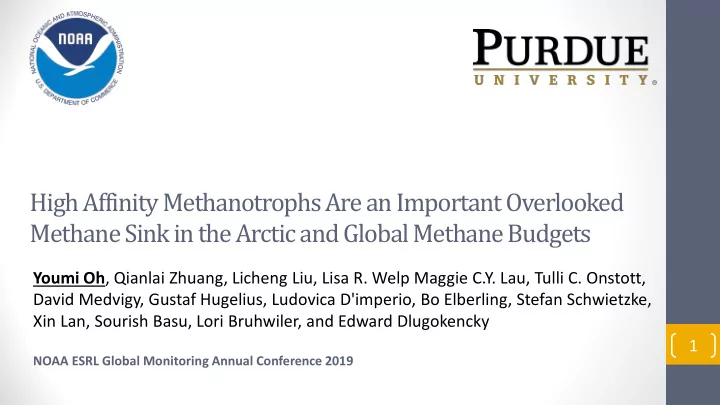

High Affinity Methanotrophs Are an Important Overlooked Methane Sink in the Arctic and Global Methane Budgets Youmi Oh , Qianlai Zhuang, Licheng Liu, Lisa R. Welp Maggie C.Y. Lau, Tulli C. Onstott, David Medvigy, Gustaf Hugelius, Ludovica D'imperio, Bo Elberling, Stefan Schwietzke, Xin Lan, Sourish Basu, Lori Bruhwiler, and Edward Dlugokencky 1 NOAA ESRL Global Monitoring Annual Conference 2019
Introduction Uncertainties in natural arctic methane budget Net Methane Emissions Simulated by CLM 4.5 Arctic Methane Budget (> 53°N) 40 30 Tg/yr 20 10 0 Methane models Atmospheric Inversions -2 2 gCH 4 m -2 yr -1 Tarnocai et al. 2009; McGuire et al., 2012; Hinzman et al., 2013; Bruhwiler et al., 2014; Lau et al., 2015; Tan et al., 2015; Saunois et al. 2016
Introduction Biogeographic differences in methanotrophs a. Wetland b. Upland CH 4 CH 4 [CH 4 ] air [CH 4 ] air LAM HAM MG CH 4 Methanogen LAM MG SOC Low affinity methanotroph HAM 3 High affinity methanotroph Le Mer and Roger, 2001; Christiansen et al., 2015
Method I added microbial and permafrost dynamics into TEM a. Wetland b. Upland CH 4 CH 4 [CH 4 ] air [CH 4 ] air ε ε m E m E MG HAM LAM Methanogen t=1,2,3… t=1,2,3… CH 4 LAM ε Low affinity methanotroph ε m E MG HAM SOC t=1,2,3… High affinity methanotroph Permafrost ε: Growth efficiency SOC 4 m E : Maintenance energy Zhuang et al., 2004; Zhuang et al., 2006; Zhuang et al., 2013; Oh et al., 2016
Method Three model setups for factorial analysis • Simulation was conducted at a spatial resolution of 0.5°×0.5° from north of 50°N for contemporary period (2000-2016) and future projection (2016-2100) Model Setup XPTEM-XHAM PTEM-HAM TEM Permafrost Dynamics ON ON OFF High Affinity Methanotrophs ON ON OFF Microbial Dynamics ON OFF OFF 5 Zhuang et al., 2004; Zhuang et al., 2006; Zhuang et al., 2013; Oh et al., 2016
Results New models show lower CH 4 emissions in 2000-2016 Annual Pan-Arctic Net Methane Emission XPTEM-XHAM 65 60 55 50 45 C H 4 /yr 40 Tg Atmospheric 35 Inversion 30 25 20 2000 2002 2004 2006 2008 2010 2012 2014 2016 Year 6 Bruhwiler et al., 2014;Lau et al., 2015; Tan et al., 2015; Saunois et al. 2016
Results New models project smaller future CH 4 emissions Annual Pan-Arctic Net Methane Emission for RCP 8.5 90 XPTEM-XHAM PTEM-HAM 80 Previous Models TEM 70 60 C H 4 /yr 50 Tg 40 30 20 2020 2030 2040 2050 2060 2070 2080 2090 2100 7 Year Schaefer et al., 2011; Koven et al., 2011; Schuur et al., 2013; Lawrence et al., 2015
Results HAM shows a better adaption strategy in the future Temperature-sensitive Pan-Arctic Net Methane Emission for RCP 8.5 40 XPTEM-XHAM XPTEM-XHAM with Microbial Adaptation 35 30 C H 4 /yr 25 Tg 20 15 10 2020 2030 2040 2050 2060 2070 2080 2090 2100 8 Year Von Stockar and Liu, 1999; Wieder et al., 2013; Trimmer et al., 2015
Implication Implication on arctic methane feedbacks High Affinity Methanotroph Activity - + - Temperature Increase + + Microbial Dynamics Methane Permafrost and Composition Emission Thaw +/- + Soil Water + Increase + 9 Well Constrained Methanogen Poorly Constrained Activity Oh et al., 2016
Introduction Models overestimated global natural methane emissions The current estimation of global methane soil sink is 30 TgCH 4 yr -1 , but • with a huge uncertainty (7 to >100 TgCH 4 yr -1 ) Mean Annual Methane Emissions from 2003 - 2012 1000 BU: Bottom -Up Methane Models TD: Top -Down Atmospheric Inversions -1 C H 4 yr 500 Tg 0 Natural - BU Natural - TD Ag/Waste - BU Ag/Waste - TD Fossil Fuel - BU Fossil Fuel - TD Bio. Burning - BU Bio. Burning - TD 10 Smith et al., 2000; Curry et al., 2007; Dutaur and Verchot, 2007; Saunois et al. 2016
Results The Global methane soil sink can be up to 3 times larger Criteria 1 (Tg CH4 yr -1 ) HAM only SOC 5% SOC 1% SOC 0.5% LAM only – max. SOC threshold 90 90 73 60 33 Criteria 2 (Tg CH4 yr -1 ) HAM only pH 6 pH 7 pH 8 LAM only – max. pH threshold 90 76 64 46 33 11 Zhuang et al., 2004; Zhuang et al., 2006; Nachtergaele, Freddy, et al. 2010
Atmospheric Inversion Inversion simulation using CarbonTracker-CH 4 NOAA in-situ data Observational Constraints CarbonTracker- In-situ and AIRS CH 4 Satellite data TM5 GOSAT Simulation Current NOAA Aircraft HIPPO Airborne XPTEM-XHAM BARCA measurement CARIBIC ARCTAS CARVE 12 Peters et al., 2005; Bruhwiler et al., 2011; Bruhwiler et al., 2014
Summary Take Home Message • We simulated less current and future net methane emissions in the Arctic by considering microbial dynamics of HAM and MG and permafrost dynamics • The preliminary results show that the global methane soil sink can be up to 3 times larger than the current estimation • Limitation and future research • Validation of the model and hypothesis using atmospheric inversions • Validation of the model for sites with a broader range of pH, SOC, and vegetation types using both high and low affinity methanotrophs using meta-data 13
Acknowledgement NASA Earth and Space Science Fellowship 14
Recommend
More recommend